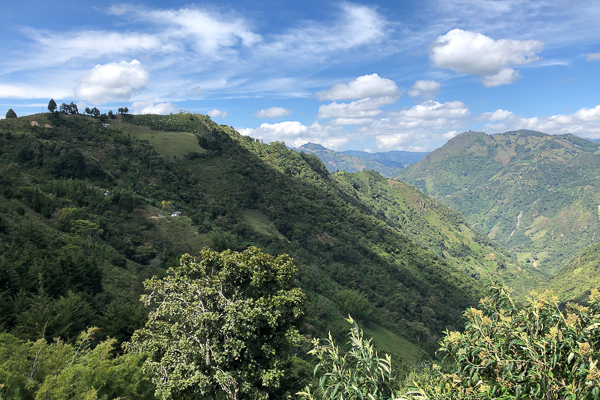Colombia’s next decade: Challenges and opportunities

By Camilo Arbelaez, Two-Year MBA ’19
Opinions in this article are of the author and do not reflect those of Cornell, Johnson, or the Emerging Markets Institute.
Colombia has made great progress since the start of the new millennium, namely when it comes to bringing an end to the armed conflict, enforcing democratic security, growing the middle class, and moving from lower value-added services to more in demand service-based products. In 2000, the country’s outlook was grim to say the least, and the country was on the verge of financial collapse after the major banking crisis in 98-99, as the ongoing Civil War was becoming more intense in the countryside and Plan Colombia (under President Pastrana) was futile in many aspects to stem cocaine production and exports to the United States.
A brief 20-year history
In August 2002, President Alvaro Uribe was sworn into office and he would commence a historic turnaround when it came to increasing military presence in the rural areas of Colombia, tilting the war in the government’s favor and weakening the rebel FARC guerillas, as well as lifting the confidence of investors about Colombia which would usher in an era of growth. In short, his policy was based on democratic security, investor confidence, and social cohesion. Basically, the first component was all about winning the war against the guerillas, the second component would lead to increased FDI and much needed capital investments in Colombia, while the third would include education, empowerment, reduced poverty and more equality.
President Uribe was the first president to change the Constitution so that the president of Colombia could serve for eight years instead of the traditional four. During his eight-year tenure, he increased foreign investment substantially and security issues regarding terrorism, kidnappings, and extortion, which went down to all-time lows and ushered in a new era in Colombia. However, his government did not go without criticism for some of the brutal tactics used to combat guerillas, and the “false positives” scandal where soldiers would falsely identify civilians as guerillas, kill them, and look to wrongly collect a bounty. There was much bloodshed and criticism in international circles of President Uribe and his possibly committing crimes against humanity. But in retrospect, the country’s general security did improve greatly, and the country began to pivot from a narco hotspot and guerilla-riddled jungle to a country with high growth and economic potential that could shine in the region.
After the Uribe administration, came President Juan Manuel Santos’ government which would take a step back from tough warfare and be more inclined towards negotiation and beginning the peace talks which would eventually “end” the Civil War and earn the president a Nobel Peace Prize along the way. Juan Manuel Santos was Uribe’s former defense minister and therefore Uribe had a large role in helping him get elected. Interestingly enough, the Santos Administration would be very oblivious of Uribe, take antagonizing stances to Uribe’s “Democratic Security” and ultimately Santos and Uribe would become political enemies during the eight years of Santos’ tenure.
The power of geopolitics
Looking back, it is interesting to note how different government regimes can all play a critical role in the geopolitics of a region and in the development of a long-term strategy. First, President Ernesto Samper was heavily criticized and rightly so, due to his “allegedly” receiving money from drug lords for his presidential campaign in 1994. This was a very low point in U.S.-Colombian political relations and his successor Andres Pastrana would play a critical role in re-building relationships with the United States (with the Clinton Administration) and securing U.S. aid to fight the drug war in Colombia. Next, Uribe would be the “warrior-like” president who intensified the military intervention in the country and slashed thousands in the guerilla ranks.
Next, President Santos would scale back on the militaristic approach and be more passive and dialogue focused which led to several years of peace negotiations with the FARC in Havana, Cuba. Although Colombians would vote against this Peace Agreement, Santos would move this through Congress through executive power and this would become a highly debated move at all levels of political discussion in Colombia. Now, at the present date, Ivan Duque is the new president, recently sworn into office in August 2018 and believed to be a successor to President Uribe, by many who supported him in hope of restoring some of Uribe’s doctrines and democratic security principles.
Economic implications
Now, to leave the political realm for a bit and to backtrack to the economic development of the country, let’s think about how the country’s economic tale has unraveled since the year 2000. As mentioned earlier, in the year 2000 Colombia was narrowly surviving the effects of the worst financial crisis in its history, along with the bad press and economic burden of the Civil War and the War against Drugs. On a macroeconomic level, conditions began to stabilize at the turn of the millennium as the Central Bank moved the country’s monetary policy to a floating exchange rate regime and therefore avoided a lot of the pain associated with a depleting level of currency reserves. Better macroeconomic policies, along with tighter budgetary control, stabilizing inflation, and rising exports, led to a growing economy. Oil prices began to rise, leading to the start of a super commodities boom in Latin America which would lift the region, and Colombia would naturally benefit from this through its state-owned oil giant Ecopetrol. In fact, the Colombian stock market rallied tremendously from 2001-2010 and in 2009 the Colombian stock market was up over 60% in that year alone and was one of the best performing markets in the world.
In 2013-2014, there would be a change of conditions, as Ben Bernanke and the U.S. Fed began their infamous “tapering” and this led to losses in treasury departments across Colombian corporates and this would soon be followed by the sudden drop in oil prices which would abruptly halt the fascinating equity stories of Colombia, Brazil, and others in the region. In fact, since 2014, the stock market has not hit its peak levels again and companies have been forced to slash costs, reduce their hiring, and in general the economy has not achieved its prior dynamism. This brings us to the present moment where oil prices are slowly creeping up again, the country is finally trying to come to ends with the Peace Agreement and the fiscal burden this entails, among others. Hence, the real question is: What comes next and what opportunities can Colombia look to capitalize on in the next few years and the decade that lies ahead?
Avenues of growth
With the commodities boom long gone, many have looked to the 4G infrastructure projects as the new avenue for growth and prosperity in the country. This can lead to some growth but the effect will never be comparable to the impact oil had a decade ago. Plus, the country’s economic and political scene is now riddled with corruption scandals relating to infrastructure projects and Odebrecht, which has spread far and wide throughout Latin America. The country is in much need of infrastructure renovation including highways along mountainous regions, bridges, tunnels, ports, and airports and this has fueled investment and created jobs throughout the country but it is not enough. Banks, along with multilateral agencies, and some government support, pledged over $20 billion to finance the 4G programs with 2019 and 2020 being highly critical years for the financial closures needed to undertake the largest projects in the program.
Beyond infrastructure, some opportunities to explore include the tech sector which has been recognized in international circles through innovation and smart cities approach which can be evidenced in places such as Medellin, which was named the Most Innovative City in the World in 2013 in a distinction made by the New York Times and Citigroup. A lot of this has to do with crafting innovative alternatives to improve mobility within the city (for example the cable cars), building public libraries and using digital initiatives to enhance education, and contribute to the progress of the city and the region.
Recent developments
In the present, the country is still a beacon of hope in the Andean region, while Venezuela continues to struggle under its current regime, and this impacts Colombia significantly as it continues to see massive migration from Venezuela. It is an additional fiscal cost for the new government which was left strapped for cash after the previous government consumed a lot of resources and never implemented a structural tax reform, which the country desperately needs. What is left now, is a country with political stability (yet mounting pressures from the left), a country with growth potential (but a government in need of money and companies and consumers which will undoubtedly pay higher taxes), and a shift toward the ultra-right in some countries in the region such as Brazil.
There may have been a peace process with the FARC guerillas, but most recently the ELN guerilla led a car bomb attack against a military school in Bogota. There are certainly many questions to be answered about how the Peace Agreement will work going forward and if the country will live up to its potential of being a growing and stable emerging market economy in years to come.

About Camilo Arbelaez, Two-Year MBA ’19

Camilo Arbelaez is a second-year MBA candidate at Johnson. Before business school, Camilo worked as an investor relations professional at Bancolombia in Medellin, Colombia. He was responsible for preparing quarterly earnings reports, 20F filings, and meeting with both equity and fixed income investors on a regular basis. Prior to this role, Camilo was an M&A investment banking analyst at Banca de Inversion Bancolombia where he worked on deals across various industries such as cement, insurance, retail, and infrastructure. He will join IBM’s Finance Leadership Development Program upon graduation. Camilo holds a BS in economics with a concentration in finance from Universidad EAFIT.

Comments